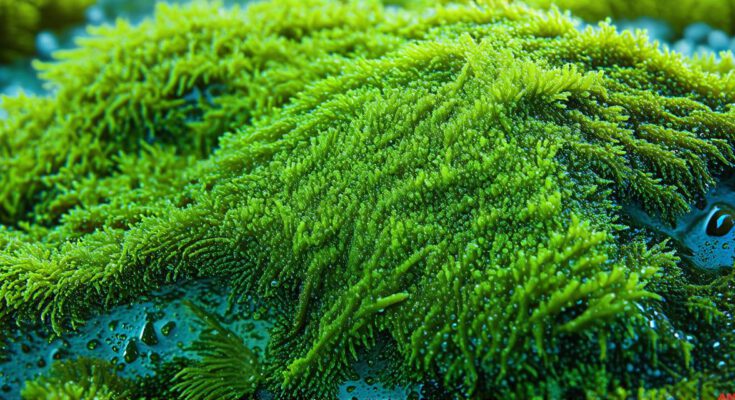Introduction
Algae and cryptogams are two groups of plants that have fascinated scientists and horticulturists alike due to their unique characteristics and functions in ecosystems. Algae, which range from microscopic single-celled organisms to large multi-cellular forms, play a crucial role as primary producers in aquatic environments. Cryptogams, on the other hand, lack specialized tissue for the production of flowers or seeds and reproduce through spores or asexually via fission. In this guide, we will explore these two diverse groups of plants in depth, including their unique characteristics, functions in ecosystems, and real-life examples.
What are Algae?
Algae is a diverse group of aquatic plants that can be found in every body of water on Earth, from freshwater lakes and streams to the deepest oceanic trenches. They are essential primary producers, converting sunlight and carbon dioxide into oxygen and organic matter through photosynthesis. Algae can be classified into two main groups based on their cell structure: diatoms and non-diatoms. Diatoms are single-celled algae with a distinctive silica shell, while non-diatoms are multi-cellular forms that lack this shell. Algae also come in various shapes and sizes, ranging from microscopic unicellular organisms to large seaweeds that can grow up to 150 feet long.
Diatoms are the most abundant type of algae in the world’s oceans, making up around 40% of the primary productivity in these ecosystems. They are essential for the survival of many marine animals, which rely on them as a primary food source. Non-diatom algae, on the other hand, are more diverse and can be found in both freshwater and saltwater environments. These algae include phytoplankton, which form the base of the ocean food chain.
Algae have numerous practical applications, including biofuels production, pharmaceuticals, and nutritional supplements. They are also used in cosmetics, such as facial masks and hair conditioners, due to their nourishing properties. Furthermore, algae can be used for wastewater treatment and carbon sequestration, helping to mitigate the effects of climate change.
What are Cryptogams?
Cryptogams are a diverse group of plants that lack specialized tissue for the production of flowers or seeds. Instead, they reproduce through spores or asexually via fission. Cryptogams can be found in every habitat on Earth, from deserts and mountains to tropical rainforests and coral reefs. They are essential decomposers and nutrient cyclers in soil ecosystems, breaking down dead plant material and recycling nutrients back into the soil for other plants to use.
Cryptogams can be classified into three main groups: mosses, liverworts, and hornworts. Mosses are non-vascular plants that lack specialized tissue for the transport of water and nutrients. They are found in moist environments and play a crucial role in soil stabilization and moisture retention. Liverworts, on the other hand, are vascular plants with specialized tissue for the transport of water and nutrients. They can be found in both terrestrial and aquatic environments and are essential decomposers in these ecosystems. Hornworts are non-vascular plants that lack specialized tissue for the production of flowers or seeds. They are found in freshwater and saltwater environments and play a crucial role in nutrient cycling in these ecosystems.
Cryptogams have numerous practical applications, including medicine, food, and biofuels production. For example, some liverworts contain compounds that have been shown to have anticancer properties, while others are used as a source of food for many animals, including insects and birds. Additionally, cryptogams can be used in the production of biofuels, such as ethanol and biodiesel, due to their high starch content.
Real-Life Examples of Algae and Cryptogams
Algae and cryptogams play essential roles in various ecosystems around the world. In freshwater ecosystems, diatom algae are a primary source of food for zooplankton, which in turn form the base of the food chain for many fish species. Non-diatom algae, such as phytoplankton, are essential decomposers and nutrient cyclers in these ecosystems, breaking down dead plant material and recycling nutrients back into the water for other plants to use.
In marine ecosystems, diatom algae form the base of the food chain for many fish species, while non-diatom algae, such as phytoplankton, are essential decomposers and nutrient cyclers in these ecosystems. Cryptogams, such as mosses and liverworts, play a crucial role in soil stabilization and moisture retention, helping to maintain the delicate balance of these ecosystems.
Frequently Asked Questions About Algae and Cryptogams
1. What is the difference between algae and cryptogams?
Algae are aquatic plants that lack specialized tissue for the production of flowers or seeds, while cryptogams are non-vascular plants that reproduce through spores or asexually via fission.
2. Are algae and cryptogams found in freshwater habitats?
Yes, both algae and cryptogams can be found in freshwater habitats, such as lakes, rivers, and wetlands.
3. What is the role of algae and cryptogams in aquatic ecosystems?
Algae play a crucial role in aquatic ecosystems as primary producers, converting sunlight and carbon dioxide into oxygen and organic matter through photosynthesis. Cryptogams are essential decomposers and nutrient cyclers in soil ecosystems.
4. Are algae and cryptogams adapted to life in extreme environments?
Yes, some species of algae and cryptogams have evolved unique adaptations that allow them to survive in harsh conditions, such as hot springs, acidic lakes, and arctic tundra.
5. What are the main groups of algae and cryptogams?
The main groups of algae are diatoms and non-diatoms, while the main groups of cryptogams are mosses, liverworts, and hornwarts.
Conclusion
Algae and cryptogams are two diverse groups of plants that play essential roles in aquatic and terrestrial ecosystems. By understanding their unique characteristics and functions, we can appreciate their importance in maintaining the delicate balance of our planet’s ecosystems. Algae and cryptogams have numerous practical applications, including biofuels production, pharmaceuticals, and nutritional supplements. As such, they are essential for human health and wellbeing and should be preserved and protected for future generations.



